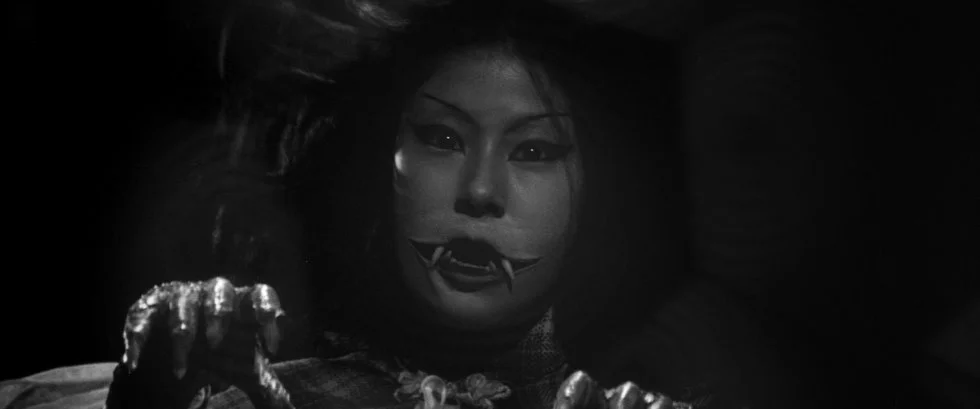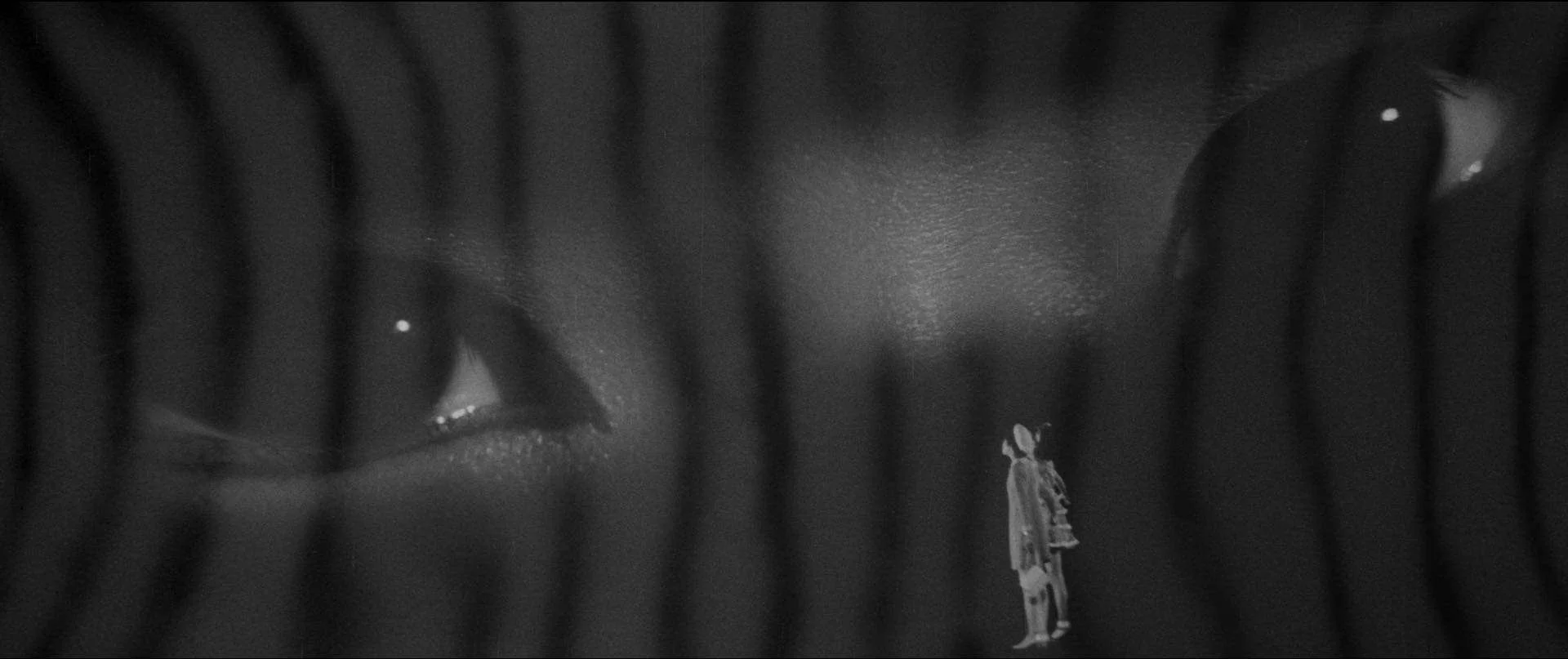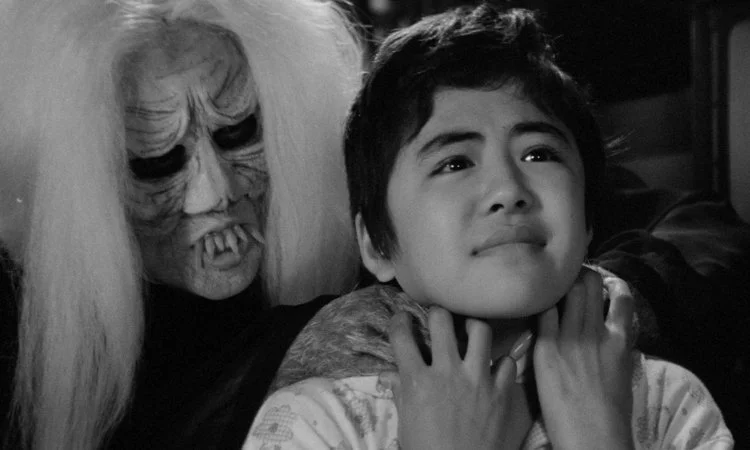[Film Review] Snake Girl and the Silver Haired Witch (1968)
The child’s point of view can be a powerful tool in horror. It can emphasise being in a position of vulnerability and true powerlessness to maximise a sense of terror, but also has the potential to tell stories of growth and resilience when the child overcomes their fears and survives their terrible ordeal. The Snake Haired Girl and the Silver Haired Witch is a wonderful example of this, and one that until recently wasn’t made available to view outside of its native Japan.
Orphan Sayuri has been told that she will be reunited with her birth parents and is excited for her new life in a big house with her own room, new clothes, and everything she could ever want. Things begin to get strange as soon as she arrives, as one of the house maids is being wheeled away having died under mysterious circumstances, and her mother has sustained a head injury which makes remembering things difficult and calls Sayuri “Tamami”. When her father, an expert on venomous snakes, gets called away to Africa suddenly to study a new specimen is when the horror for Sayuri truly begins.
Whilst not based on a single work and instead taking elements from a few of his stories, The Snake Girl and Silver Haired Witch is derived from the works of manga artist Kazuo Umezu, a leading figure in horror manga with a career that started in the early sixties and is still going strong today (for more on Umezu’s role in the growth of girls’ horror in Japan, see here). He is particularly known for often centring his stories around innocent and wide-eyed child protagonists attempting to find their way out of horrific situations. That is present here with protagonist Sayuri, and we often hear her inner monologue, something that feels fitting for a film that takes elements from a manga story format. The film’s director was Noriaki Yuasa in what is a departure from the rest of his career, which almost exclusively comprises films featuring Gamera, Daiei’s kaiju series created to compete with Toho’s Godzilla. It is a shame, because The Snake Girl and the Silver Haired Witch does show an interesting style and it would have been nice to see Yuasa develop that more.
This really is a really fun movie, something evident immediately from the Gothic quality to the film’s set-up as we follow the innocent young orphan who is whisked away to an elaborate mansion full of strange objects and forbidden rooms, her new mother acts strange and aloof, there is a mysterious person living in the attic watching everything that goes on, nuns, and a family secret to uncover. Said family secret is the actual Tamami, Sayuri’s apparently hidden from public eyes older sister who takes an immediate dislike to the girl despite Sayuri’s best efforts. She is the titular Snake Girl, although the nature of that is ultimately slightly ambiguous. It is brought out most in visually creative dream sequences that are almost a tamer version of some of the visuals in Nobuhiko Obayashi’s House, who himself adapted Umezu’s work in 1987 with The Drifting Classroom. There are some moments where the effects show their cheapness, but if anything that just adds to the film’s charm. What these scenes achieve is really blurring the lines between fantasy and reality, making you question the exact nature of what is happening to Sayuri as well as heightening the feeling of childhood terror she is going through.
Of course, what is children’s horror without the child central to it all and Sayuri, played by ten year old Yachie Matsui, has a plucky sweetness to her that you can’t help but root for. She tries to make the best of her new situation, even with Tamami’s cruelty and housekeeper Shige’s disbelief at anything she says. Her only true ally is Tatsuya, an older boy from the same orphanage as her. It’s interesting and even keeps you guessing in a few places. There was a point when I thought that the father’s work with venomous snakes was going to play a more experimental part in an Eyes Without a Face fashion, especially when we see a scar along the edge of Tamami’s face. The actual sinister plot behind everything is a bit more Scooby-Doo than French New Wave, but still entertaining.
The Snake Girl and the Silver Haired Witch has that fun children’s horror quality; not really scary, but an entertaining and fun watch. This could even be a good gateway film for people introducing someone to Japanese horror as it's fairly light on specific cultural elements but can introduce someone to the particular mood, attitude towards monsters, and touches on the things that veteran fans of Japanese horror would already be familiar with.






![[Film Review] Shaky Shivers (2022)](https://images.squarespace-cdn.com/content/v1/5fe76a518d20536a3fbd7246/1696442594997-XMJSOKZ9G63TBO8QW47O/Screenshot+2023-10-04+at+18.59.33.png)
![[Film Review] Elevator Game (2023)](https://images.squarespace-cdn.com/content/v1/5fe76a518d20536a3fbd7246/1696440997551-MEV0YZSC7A7GW4UXM5FT/Screenshot+2023-10-04+at+18.31.42.png)
![[Film Review] Kill Your Lover (2023)](https://images.squarespace-cdn.com/content/v1/5fe76a518d20536a3fbd7246/1697465940337-T55VQJWAN4CHHJMXLK32/56_PAIGE_GILMOUR_DAKOTA_HALLWAY_CONFRONTATION.png)
![[Film Review] Mercy Falls (2023)](https://images.squarespace-cdn.com/content/v1/5fe76a518d20536a3fbd7246/1695482997293-E97CW9IABZHT2CPWAJRP/Screenshot+2023-09-23+at+16.27.27.png)
![[Film Review] Perpetrator (2023)](https://images.squarespace-cdn.com/content/v1/5fe76a518d20536a3fbd7246/1695483561785-VT1MZOMRR7Z1HJODF6H0/Screenshot+2023-09-23+at+16.32.55.png)
![[Film Review] Sympathy for the Devil (2023)](https://images.squarespace-cdn.com/content/v1/5fe76a518d20536a3fbd7246/1697186986143-QDVLQZH6517LLST682T8/Screenshot+2023-10-13+at+09.48.52.png)
![[Film Review] V/H/S/85 (2023)](https://images.squarespace-cdn.com/content/v1/5fe76a518d20536a3fbd7246/1697455043249-K64FG0QFAFVOMFHFSECM/MV5BMDVkYmNlNDMtNGQwMS00OThjLTlhZjctZWQ5MzFkZWQxNjY3XkEyXkFqcGdeQXVyMTUzMTg2ODkz._V1_.jpg)






















![[Editorial] 10 Films & Events to Catch at Soho Horror Film Fest 2023](https://images.squarespace-cdn.com/content/v1/5fe76a518d20536a3fbd7246/1700819417135-299R7L4P0B676AD3RO1X/Screenshot+2023-11-24+at+09.41.52.png)
![[Editorial] 9 Horror Nintendo Switch Games To Play](https://images.squarespace-cdn.com/content/v1/5fe76a518d20536a3fbd7246/1697214470057-3XZXX8N4LYIMDFWS6Z3P/Screenshot+2023-10-13+at+17.20.13.png)
![[Mother of Fears] Mothering in Silence in A Quiet Place (2018)](https://images.squarespace-cdn.com/content/v1/5fe76a518d20536a3fbd7246/1696445921315-HZJ2DZYQIH6VVWXBO2YL/Screenshot+2023-10-04+at+19.52.29.png)
![[Editorial] 5 Female Focused Horror Book Recommendations](https://images.squarespace-cdn.com/content/v1/5fe76a518d20536a3fbd7246/1696441981361-52EQCTJ7AT2QF1927GM7/919xtm6d3fL._AC_UF894%2C1000_QL80_.jpg)
![[Editorial] 9 Best Slashers Released Within 10 Years of Scream (1996)](https://images.squarespace-cdn.com/content/v1/5fe76a518d20536a3fbd7246/1695478839037-LOFHGVM3H6BMSZW7G83M/Screenshot+2023-09-23+at+15.15.11.png)
![[Mother of Fears] Mother Vs. Monster in Silent Hill (2006)](https://images.squarespace-cdn.com/content/v1/5fe76a518d20536a3fbd7246/1695485781119-H6GNP0G3J2TLPAOIABV7/Screenshot+2023-09-23+at+17.11.56.png)
![[Editorial] 9 Terrifying Cerebral Visions in Horror Movies](https://images.squarespace-cdn.com/content/v1/5fe76a518d20536a3fbd7246/1693509801235-X23OL50T1DVGECH0ZJK2/MV5BMjQ0MTg2MjQ4MV5BMl5BanBnXkFtZTgwMTU3NDgxMTI%40._V1_.jpg)
![[Mother of Fears] I Don’t Wanna Be Buried in a Pet Sematary (1989) and (2019)](https://images.squarespace-cdn.com/content/v1/5fe76a518d20536a3fbd7246/1691328766069-QFNAVJOMFZVZ5CLU1RWM/Screenshot+2023-08-06+at+14.23.13.png)

A Wounded Fawn (Travis Stevens, 2022) celebrates both art history and female rage in this surreal take on the slasher genre.